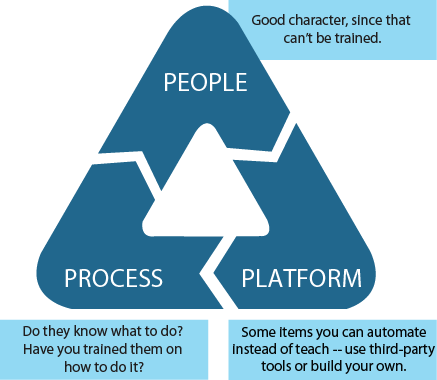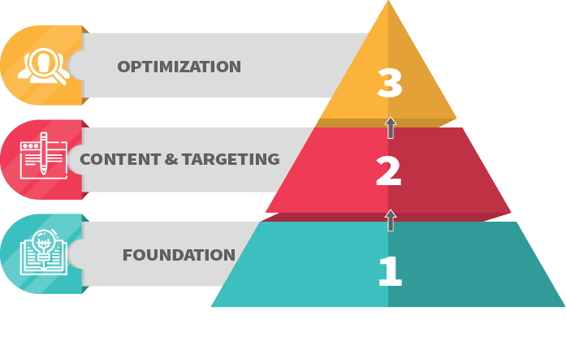STARTING YOUR AGENCY
You’re good at what you do; clients wouldn’t hire you if you weren’t.
But you’re afraid that, by hiring more people, you’ll lose the personal touch and the quality of your services will go down.
At the same time, your business is growing and you’re not going to be able to sustain this current effort level.
Marketing > Set-up Process #GCT > Operations (Package/Course DIY) So something has to give: scale up (what you’d like to do), decline business (not smart in the long run), or work harder (impossible).
Clients come to you because of your expertise and relationships.
When you’re small, you are the face of your business, so your personal brand and company brand are synonymous.
Scaling an agency means starting with the ONE thing you do well, doing it repeatedly, documenting how you do it, training others how to do it, and making a franchise of it.
A franchise means repeatable excellence. This means you must have checklists for others to reliably do. Then you’re not stuck doing the work yourself, or worse, constantly trying to Agency Management Course 5 fix the broken work of others. The “E-Myth” talks about this conceptually, that your goal should be to work ON your business instead of IN your business. But to put it in practice, you need to package up what you do.
Where are your packages? What is the one thing you do well (and have public proof of it), such that you can explicitly say you DON’T do everything else?
First, start documenting how to do the simple things Master Agency Management | page 16

Billing clients, weekly performance reporting, and other simple stuff should be driven by checklists.
But it’s not just the menial tasks. If you stand for something so passionately, you have the knowledge necessary to build checklists so that other people can follow along and do all kinds of things.
We’ve created checklists for things like how to set up Google Ads, Google Analytics, successful Facebook campaigns using custom audiences, etc.
You can have junior folks do these things so you can focus on the 10% of the stuff that is truly high-impact.
If you have these three, you can attend every other meeting instead of all meetings (alternating tactical versus strategic).
Boil down your offering to just the essentials
Make a package that you can reliably and consistently execute, allowing you to know that your training and agency are aligned.
Clients don’t want custom as much as you think-- they want results.
Before you argue that this sounds cookie-cutter or eliminates thinking, would you say that a Tesla is low quality?
Even movie studios have a process for how they create films - a framework that enables creativity versus no structure leading to chaos.
If you seek to do things differently for the sake of doing it differently, be prepared to fail a lot.
You want to use proven techniques, especially if you’re doing something that can have standards, such as advertising, website building, or anything in digital.
Think about what happens inside the emergency room; lots of people are coming in with gunshot wounds, arms cut off, fevers, hypochondria, cancer, etc. These patients are not going to go in asking the doctors to offer them a Master Agency Management | page 17

full list of every single treatment they know how to do. The doctor is going to perform an assessment, identify what’s wrong, prioritize, and then treat the patient.
You have to operate your agency like an emergency room, otherwise you’ll end up running around treating every problem your clients might think they have, when the real problem is really something else. Both parties end up wasting their time and nothing really gets fixed.
Do you know what items have the highest impact? Probably those items that are strategic in nature, leaving tactical stuff to be competently handled by the rest of your team. Your documentation should be step-by-step checklists assisted with video training snippets to make it easier to digest.
Use this same training to qualify your prospective staff as a real life litmus test of what to expect. In doing so, you’ve also solved the burden of having to interview and qualify people one at a time -- a real time suck. Tools like Infusionsoft and LearnDash let you run people through self-serve training and quizzes which you can use in the qualification process.
Get out of the day-to-day
Hire a project manager if you need to. Ironically, if you truly want to help your clients, you’ll focus more on troubleshooting than administrative details you can delegate. This requires that you trust the people you’ve been training. We look at three criteria for success:
Master Agency Management | page 18


One effective strategy to initially wean clients off you personally is to say that you’ll show up midway through the meeting.
They’ll later find that you didn’t have to be there the whole time, giving your people a chance to shine.
Don’t worry about “cutting out” of meetings — if you’re really that good at what you do, clients would expect that you are delegating to handle the workload.
Ideally, you should just review the work instead of doing it all yourself. If your process is solid (checklists with training videos), you should have consistent delivery.
Follow the Content>Checklist>Software process to scale up.
You can share your training publicly.
Don’t be afraid of your “competitors” stealing your know-how or clients deciding they don’t need you. If that were to happen, then you don’t know enough or have enough depth to deserve serving clients.
Master Agency Management | page 19

What happens in most cases is that prospective clients appreciate your sophistication, and this INCREASES your new client growth.
Engage in content marketing with no fear.
Fire the bottom third or more of your clients — the ones that are a big headache or make your staff unhappy. The clients who treat you best are usually the ones who pay the most and demand the least.
You should keep the kind of clients you want more of, handing the rest to
“competitors”. Doing this will help you have consistency across what you offer and can allow you to double down on process bits instead of trying to do everything.
The corollary to focusing on the ONE thing you do well, then doing it over and over, is to say what you DON’T do.
We like to say we don’t make creatives, don’t do SEO, don’t do community management, and don’t do strategy.
What we do is implementation - drive traffic and conversions on existing assets that are already converting.
The marketplace will believe you when you demonstrate your world class at doing one thing repeatedly well.
A good test for a great client is to raise prices. *Gasp!* I said it.
If you’re truly delivering value, they’ll have no problem paying more.
I often struggle with mustering the courage to do this, but if you’re proving your value, then making the case should be easy.
You don’t want to be the cheapest, and you do want a few clients to balk at your price. If nobody ever balks at your price, you’re undercharging for most deals, and those who are paying less will often think you’re not as good, since your prices are low-- a double whammy.
Master Agency Management | page 20

Analytics, Twitter, etc.) on a website. A single container of source code is loaded on a website. The container then loads pixels (or 3rd party tags like GCT: goals, content, and targeting = business strategy Goals=metrics=strategy=optimization, since business goals must be quantifiable and actionable.
A business’s goals must reflect their true mission to inspire customers to genuinely identify and share. Start with “WHY”.
Thus content production is an ongoing validation of your mission and values delivered to audiences.
Targeting takes three forms: what (search keywords), where (print, TV, traditional), and who (people-based targeting).
While we need all three types, the most sustainable is people based targeting: personalized marketing based on what someone has done and who they are.
People-based targeting via core audiences and lookalikes has owned, earned, and paid components.
Who are your best customers and how do we get more of the same?
Organize customers into personas, which guides content production.
Database marketing (or personalization) is delivering the right message to the right user at the right time.
Marketing automation is the automation of these personalization sequences, but it requires having each component of GCT in place.
Strategy Assessment Check
● Create a list of questions for qualifying leads.
● Create a Strategy Assessment form with or without
● Infusionsoft.
● Install the Strategy Assessment form.
● Create a basic sequence for “if/then” for selling to leads.
Master Agency Management | page 21


Your Business Success Starts With Your Personal Brand LibraryAccess to these
Assets you’ll leave with:
courses:
● One-minute video Course
● Social Accounts and Public
● Facebook for a Dollar a Day
Figure Pages
Course
● Facebook Ad Account through
● Micro Targeting Course
Business Manager
● Standards of Excellence
● Why Video
Course
● 3x3 goals
● Optimization Course
● Topic Wheel
● Optimization Webinar
● Boosted Posts
● Google Ads Course
● 3x3 Video Grid
● Facebook BluePrints Courses
● Content Library
Master Agency Management | page 22


Create Goals & Tune Your Profiles
1
2
3













